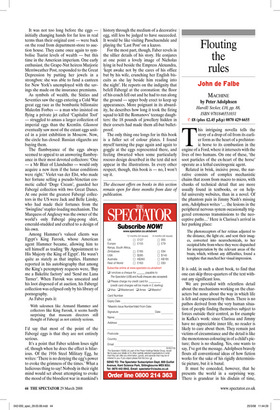Flouting the rules
John de Falbe
MACHINE by Peter Adolphsen Harvill/ Secker, £10, pp. 88, ISBN 9781846551031 ✆ £8 (plus £2.45 p&p) 0870 429 6655 This intriguing novella tells the story of a drop of oil from its earlier form as the heart of a prehistoric horse to its combustion in the engine of a Ford, where it intersects with the lives of two humans. On one of these, ‘the soot particles of the ex-heart of the horse’ operate as a lethal carcinogenic agent.
Related in brisk, incisive prose, the narrative consists of complex mechanistic chains that zoom from macro to micro, with chunks of technical detail that are more
1 P
usually found in textbooks, or on helpful university websites, than in a novel. Of the phantom pain in Jimmy Nash’s missing arm, Adolphsen writes ‘... the lesions in the peripheral nervous system occasionally triggered erroneous transmissions to the neoceptive paths...’ Here is Clarissa’s arrival in her parking place:
The photoreceptors of her retinas adjusted to the distance, the light etc. and sent their images, converted into neurochemicals, to her occipital lobe from where they were dispatched for interpretation by the relevant areas of the brain, which, without any difficulties, found a template that matched her visual impression.
It is odd, in such a short book, to find that one can skip three-quarters of the text with out any significant loss.
We are provided with relentless detail about the mechanisms working on the characters but none about the way in which life is felt and experienced by them. There is no pathos derived from the very human situation of people finding themselves subject to forces outside their control, as for example in Kafka’s work: since Clarissa and Jimmy have no appreciable inner life, no reader is likely to care about them. They remain just victims of circumstance and the detail is like the monotonous colouring in of a child’s picture; there is no shading. Yes, one wants to say, I’ve got the message. Adolphsen bravely flouts all conventional ideas of how fiction works for the sake of his rigidly deterministic picture, but it is banal.
It must be conceded, however, that he presents the world in a surprising way. There is grandeur in his disdain of time, where eons and nanoseconds have equal value as mere processes. And in the consistency and elegance of his construct there may be found a chilly beauty that might, as his conclusion implies, offer some redemption from the single, value-free dimension of his vision. Yet it feels more like a technical exercise rather than a developed work of art.

















































































 Previous page
Previous page